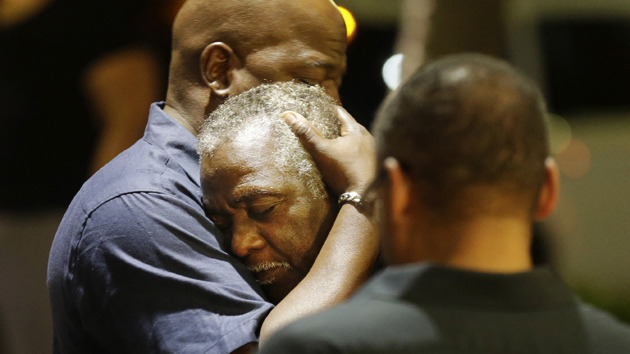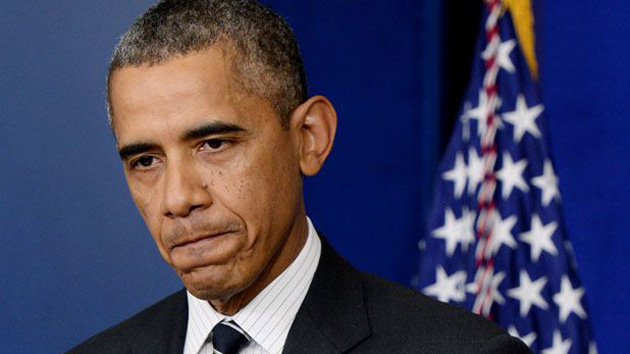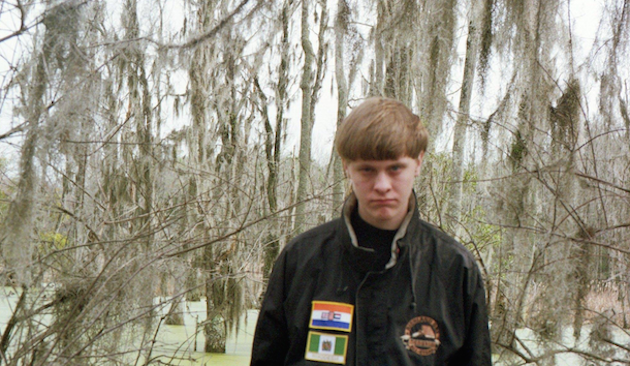
Worshippers embrace following a group prayer across the street from the scene of a shooting at Emanuel AME Church.David Goldman/AP
While big questions remain about what led to the horrific shooting that left nine dead during a prayer meeting in Charleston this week, investigators believe the massacre might have been racially motivated. A Justice Department spokesperson said federal officials with the department’s Civil Rights Division, the FBI, and the US Attorney’s Office will be investigating the attack as a hate crime.
But one prominent counterterrorism expert says calling the massacre a hate crime doesn’t go far enough: This was an act of terrorism, says Daryl Johnson, who led a team of domestic terror analysts at the Department of Homeland Security from 2004 to 2010. Johnson, who now runs a private homeland security consulting firm called DT Analytics, told Mother Jones that the Charleston attack may be part of a rise in American extremism. It’s the type of homegrown terror attack Johnson has been warning about for years.
The attacker “went into a church that has symbolic value to a faith-based community,” Johnson said, emphasizing the historical importance of the Emanuel AME Church where the killings took place. “He chose a symbolic target, and that is exactly what terrorists do when they want to send a message and instill fear in a population. That is why this is terrorism, and not simply a hate crime.” Johnson’s opinion was echoed widely on social media on Thursday, as a debate raged about how to classify the Charleston attack: hate crime or terrorism? (Gawker has this excellent counterpoint.)
The suspected shooter, a white 21-year-old named Dylann Roof, has been described by a classmate as someone with “strong conservative beliefs” and “that kind of Southern pride,” and he was known to make racist jokes. Pictures on Roof’s Facebook page depict him sporting pro-apartheid patches and posing with a Confederate flag license plate. It’s still unclear if he had any ties to official hate groups. In fact, white supremacist groups online have distanced themselves from the massacre, expressing concerns that the attack makes them look bad. But a witness told NBC that when members of the congregation tried to talk the shooter down during the attack, he responded by saying, “You rape our women, and you’re taking over our country. And you have to go.”
In January 2013, the DHS released a report analyzing the growing danger of right-wing extremism, indicating that domestic extremism could be more of a threat than foreign Islamic terrorist groups. A 2012 white supremacist attack against a Sikh temple that left six people dead prompted media interest in these sorts of targeted crimes and even led to a Congressional hearing. But Johnson says a critical blind spot remains in what we know about homegrown extremists. He blames an over-allocation of resources to fight threats from abroad, despite evidence of mounting threats from within.*
While FBI numbers show that hate crimes appear to be declining nationally, the number of hate groups—whose beliefs or practices attack or malign an entire class of person—has increased by up to 60 percent from 2000, according to the Southern Poverty Law Center:

Johnson’s program at the DHS—which he says included eight members who monitored extremist websites for anything criminal, tracked trends and tactics, and worked with law enforcement to assess threats—was gutted in 2009 after a report on the rise of right-wing extremism became public, prompting conservative outcry. Republican lawmakers and bloggers said the report unfairly painted military veterans as right-wing extremists.
The Southern Poverty Law Center, a nonprofit advocacy organization, still maintains a database called “The Extremist Files” that profiles prominent hate groups and extremist movements and ideologies, but Johnson hopes more will be done to get lawmakers to take note. “Hopefully this will get the attention of those in charge of not only enforcement, but also those making our laws,” he said. “Try to wrap your arms around this problem and try to actually develop a strategy to combat it and mitigate it. That is not being done.”
Still, as former Mother Jones reporter Adam Serwer pointed out in his 2011 coverage of the Sikh temple shooting, surveillance doesn’t always lead to prevention and can impede constitutional rights:
“Mike German, a former FBI agent who did undercover work infiltrating extremist groups including neo-Nazis and militia groups and is now senior policy counsel for the ACLU, told me that more government surveillance isn’t the solution, and that it’s a mistake to think there’s a technological silver bullet that can flawlessly identify threats before they can be carried out. Most people with extreme views, German says, hold horrible (but constitutionally protected) beliefs they never act on.”
After Johnson left the DHS, the agency contended it was doing all it could to prevent domestic terror. As WIRED reported, DHS spokesman Matt Chandler responded by saying that the “DHS continues to work with its state, local, tribal, territorial, and private partners to prevent and protect against potential threats to the United States by focusing on preventing violence that is motivated by extreme ideological beliefs.”
Correction: An earlier version of this story incorrectly stated the timing of a DHS report on right-wing extremism. It was released in January 2013, not “earlier this year.”












